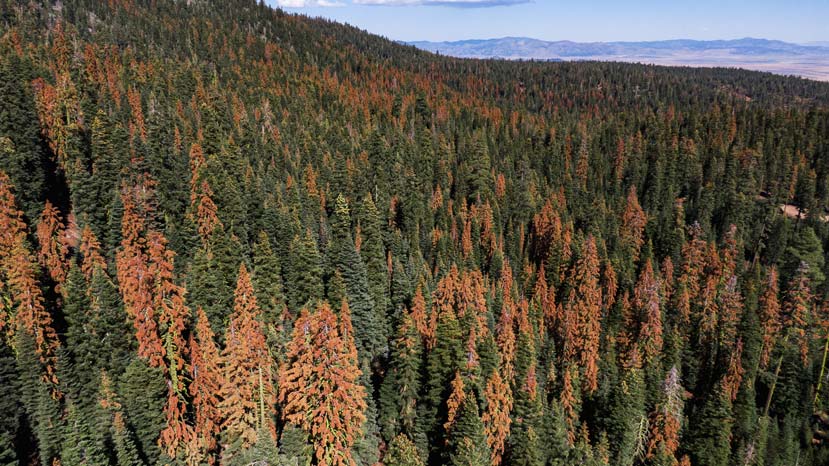From the Sierra Nevada Conservancy. A natural thinning — natural and due to climate change.

In 2022, preliminary results from the U.S. Forest Service’s Aerial Detection Survey, and field observations, suggest the emergence of a new tree mortality event disproportionately impacting higher-elevation fir forests in the northern and central parts of the state.
For some Californians, it has evoked a not-so-distant memory of the devastating southern Sierra tree mortality outbreak on the heels of the 2012–2016 drought, and the dangerous and unprecedented behavior of the 2020 Creek Fire that burned through the heavily impacted areas. For others, particularly in the central and northern part of our state that was largely unaffected by that event, it raises new concerns about forest ecosystem health and mounting wildfire risk.
What happens next will depend on future weather patterns, and whether land managers can catch up on long-needed, forest-restoration efforts.
Drivers of tree mortality
Large-scale tree mortality is mainly driven by abnormally high temperatures and prolonged drought, as scarcity of water strains otherwise healthy trees. The lack of water supply is exacerbated by increased competition among trees located in dense forests.
Unfortunately, many forests throughout the Sierra Nevada are two to five times denser than historical levels, largely due to removal of fire from the landscape. The dense stands of weakened water-stressed trees are more susceptible to diseases and insect infestations.
I have always thought that wildfires were a mechanism for massive beetle blooms, especially during drought conditions. When the blooms get so massive, even healthy and strong trees are overcome. Within fire footprints, the survivors of the fire are often the victims of bark beetles in the next two years. When they drift out of the burned areas, they find drought-stressed trees that are quite ripe for more blooms. It’s like a ‘biological wildfire’, as some have called it.
“Loss of a significant amount of carbon absorbed and stored, and an increase in greenhouse gas emissions. In 2021, more than 7 million trees died throughout the Sierra—many of them large trees that were absorbing and storing large amounts of carbon. Those trees are no longer actively sequestering carbon, with nothing to replace that loss over the short- to medium-term.’
As I said before, dead trees store carbon but don’t sequester it so it’s better to have living trees than dead ones from the carbon perspective; but carbon isn’t the only perspective. People and wildlife often prefer forests of living trees to forests of dead trees.
If you zoom in, you can see some remains of the charred logs, which used to be protected old growth, within Yosemite National Park, 33 years ago.
https://www.google.com/maps/@37.7106176,-119.7495306,1163m/data=!3m1!1e3?hl=en
How long can Sierra snags (and their carbon) be expected to last, in today’s era of human-caused wildfires and drought?
Actually, dead trees & wood on the ground are carbon sources as they emit carbon at varying rates depending upon species, localized climate & interactions with fungi, micro-invertebrates and insect.